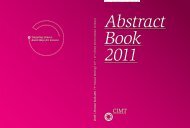Abstract Book 2010 - CIMT Annual Meeting
Abstract Book 2010 - CIMT Annual Meeting
Abstract Book 2010 - CIMT Annual Meeting
Create successful ePaper yourself
Turn your PDF publications into a flip-book with our unique Google optimized e-Paper software.
084 Chen | Tumor biology & interaction with the immune system<br />
Disturbed NK cell function in CML patients at diagnosis does<br />
not recover under treatment with imatinib mesylate<br />
Christiane I-U. Chen 1 , Steffen Koschmieder 2 , Linda Kamp 2 , Holden T Maecker 3 , Wolfgang<br />
Berdel 2 , Heribert Jürgens, 1 Peter P Lee 4 , Claudia Rössig 1<br />
1 Department of Pediatric Hematology and Oncolocy, University Hospital Muenster, Germany<br />
2 Department of Medicine, Division of Hematology and Oncology, University Hospital Muenster, Germany<br />
3 Human Immune Monitoring Center, Stanford University School of Medicine, USA<br />
4 Department of Medicine, Division of Hematology, Stanford University, USA<br />
Even though the tyrosine kinase inhibitor imati-<br />
nib mesylate (imatinib) has become the first-line<br />
therapy for patients with chronic myeloid leukemia<br />
(CML), allogeneic hematopoietic stem cell transplantation<br />
(HSCT) remains the only curative treatment.<br />
The important contribution of the immune<br />
system to curing CML is evidenced by the potent<br />
therapeutic effects of donor lymphocyte infusions.<br />
In addition to cytotoxic T cells, natural killer (NK)<br />
cells may be involved in immunologic control of the<br />
disease. Here, we used a transgenic tet-off inducible<br />
CML mouse model as well as peripheral blood<br />
samples from CML patients to explore the role of<br />
NK cells in CML.<br />
Splenic lymphocyte subpopulations from CML<br />
mice were analyzed by flow cytometry. Under continuous<br />
tetracycline treatment (tet-on), these mice<br />
have a bcr-abl-negative phenotype, whereas withdrawal<br />
of tetracycline induces bcr-abl transgene<br />
expression, resulting in initiation of leukemia and<br />
manifestation of a CML-like phenotype (tet-off, bcrabl+).<br />
Bcr-abl+ mice had significantly decreased<br />
relative numbers of NK cells compared to control<br />
mice (5.5% vs 13.8%, p = 0.045). While ex vivo expansion<br />
of purified NK cell populations from tet-on<br />
and tet-off mice demonstrated similar proliferative<br />
responses to stimulation with high-dose interleukin-2<br />
(IL-2), the cytolytic capacity of NK cells expanded<br />
from bcr-abl+ mice against K-562 cells was<br />
significantly reduced (10.7% vs. 27.3% at an E:T<br />
ratio of 1:1, p < 0.05).<br />
To address the functionality of NK cells in human<br />
CML, we quantified NK cells in peripheral blood<br />
samples from 13 patients at diagnosis and at several<br />
time points during imatinib-induced remission<br />
(range 10-59 months). Compared to age-matched<br />
healthy controls, NK cells were decreased at diagnosis<br />
(4,4% vs 13%, p < 0.05) and did not recover<br />
to normal levels under imatinib treatment (6.2% vs<br />
10%, p < 0.05). Functional experiments revealed<br />
reduced expansion of NK cells in response to coincubation<br />
with K-562/4-1BBL/mbIL-15 stimulator<br />
cells in CML patients versus healthy controls<br />
(26-fold expansion vs 48-fold expansion within 10<br />
days, p < 0.05). Moreover, the cytolytic activity of<br />
human CML NK cells was reduced both at diagnosis<br />
(8.3% lysis of K-562 target cells at an E:T ratio<br />
of 1:1) and under treatment with imatinib (11%)<br />
compared to control (18.9%, p < 0.05).<br />
We conclude that patients with CML have both<br />
quantitative and qualitative defects within their<br />
NK cell compartment, which can be reproduced<br />
by transgenic bcr-abl expression in mice. NK cells<br />
do not recover to normal levels and normal function<br />
under imatinib treatment, even after obtaining<br />
complete remission. Further work will aim at<br />
identifying the underlying mechanisms of NK cell<br />
deficiency in CML, and the development of strategies<br />
to exploit NK cells for immunotherapy of the<br />
disease.<br />
133



